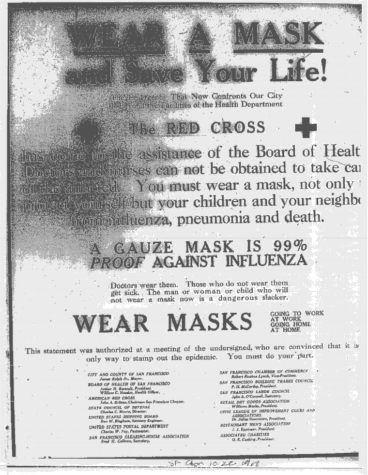The “Mask Slackers” of the 1918 Pandemic — Different Time, Same Complaint
A comparison of the San Francisco Anti-Mask League with today’s mask-mandate resistance.

With arguments over masking happening across the country, America’s mask predicament is nothing new. In fact, it’s at least a hundred years old.
“Three Shot in Struggle with Mask Slacker” read the headline of an article published by The San Francisco Chronicle on October 29, 1918, describing an incident that was not the only form of resistance the city would face. The San Francisco Anti-Mask League would continue to oppose public health ordinances until its disbandment in January of 1919. Some 100 years later, the nation has found itself in a similar situation: months of isolation, a deadly virus on the loose, and still the same reluctance to don face masks.
In 1918, a deadly influenza virus ravaged the nation. The city of San Francisco faced mounting opposition to its pandemic response, worsening from the fall of 1918 through early 1919. The Board of Supervisors ordered the first mask mandate in California on October 25th, 1918, as well as the closure of places of public gathering such as businesses, theaters, and eateries. The city government even had help from the Red Cross whose advertisement in an October 1918 edition of The San Francisco Chronicle referred to those refusing to wear masks as “dangerous slacker[s]”, and sold face coverings outside of buildings with heavy foot traffic in order to promote compliance. Despite these measures, law enforcement made many arrests for improper mask wearing, with some perpetrators paying fines or even serving short prison sentences. This strict enforcement dropped the number of new cases, and the city ended its mandate around a month later.

The measure unfortunately proved premature, similar to the loosening of COVID-19 restrictions during the Spring of 2021, and cases began to rise again that December 1918. This time around, the Board of Supervisors elected to keep businesses open and strongly encouraged (but did not mandate) mask-wearing. However, this effort did not prove to be enough, as the city was forced to order a second increasingly unpopular mask mandate less than a month later. In response to the ordinance, the San Francisco Anti-Mask League was formed, composed of residents who were resentful towards governmental overreach and doubtful of masks’ efficacy against the virus. Led by Emma Harrington, a political opponent to the mask-donning mayor, the League held a public event on January 25th, 1919 and composed a petition demanding the city to repeal the mandate. While their efforts were not directly successful, the decrease in cases during early February 1919 resulted in the removal of the ordinance.
There are two main differences between the anti-maskers of yesteryear and today: their scientific and sociopolitical contexts. A main complaint from the Anti-Mask League was regarding the ineffectiveness of masking. This was actually not solely an argument the “slackers” made, since leading scientific professionals were also questioning the efficacy of masks. According to Bronx Science A.P. U.S. History teacher Dr. Davis, this complaint was a “legitimate suspicion,” since “masks were made out of gauze and were much less reliable.” In 1918, surgical masks were made from a porous gauze material, a far cry from the triple-layered polypropylene ones used today, making the level of protection barely satisfactory. The rise in cases despite mask-wearing can be partly attributed to this ineffectiveness. However, the number of cases still dropped after the city’s second mandate, indicating that the technology of the era was better than nothing.
The second difference is sociopolitical context. The Influenza pandemic began at the tail end of the First World War, which was not popular at the time. Dr. Davis argues, “People were divided along ethnic lines in terms of who they wanted to support in the war. Irish people didn’t like England, German-Americans didn’t like England, and vice versa,” adding, “you had ideological divisions as well. You had people who thought World War One was a war over capitalist greed and imperial domination.” Suffrage, race relations, and the Red Scare were also politically contentious issues at the time. However, Dr. Davis also contends that the political fragmentation of the period does not directly compare to today’s heated political climate. “We’re polarized into teams more so today than Americans were then. All those divisions were fragments all over the place. Whereas now, we’re divided into red states and blue states, and urban versus rural. There’s two sides, and you have to choose one, and if you go along with the position of the other side, you are betraying your cause.” Davis continued, “people in this country [now] see the other team as foreign.”
Furthermore, the early 20th century arguably did not have the same level of distrust of expertise and the federal government that the modern United States has in 2021. Dr. Davis believes that, “there was less of a tendency to suspect that the government was working against popular interest” during the era because of the war. “People thought that wearing the mask was a war measure, so you had more sense of unity in that regard.” Davis added, “there’s a deep suspicion of expertise now. It’s associated with condescension and liberal elites, and it’s a buzzword. It’s not respected nearly as much,” which makes ignoring public health advice much easier and more acceptable.
For those surprised at the rise of modern anti-maskers, there is somewhat heartening news. American resistance to government mandates is nothing new. What remains concerning, however, is how much larger in number today’s anti-maskers are, and the normalization of rejecting the advice of professionals. Those two aspects joined together make for a deadly combination.
“There’s a deep suspicion of expertise now. It’s associated with condescension and liberal elites, and it’s a buzzword. It’s not respected nearly as much,” said Dr. Davis, A.P. U.S. History teacher
Meriel Crowley-Wang is an Editorial Editor for ‘The Science Survey.' She enjoys the logical way in which journalistic writing presents itself to the...
